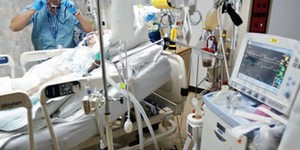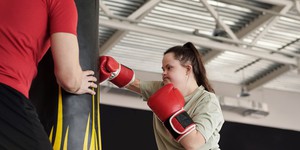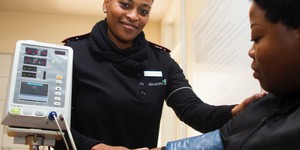Abstract
How much air do you think you breathe in when you take a deep breath? Can you increase your lung capacity by exercising regularly? Do athletes have greater lung capacity than non-athletes? This project shows you how you can find out.Summary
This project requires the participation of volunteers. Make sure you are familiar with your science fair's rules about tests involving human volunteers before you start. For suggestions and common rules check out the Science Buddies resource Projects Involving Human Subjects.
Andrew Olson, Ph.D., Science Buddies
Sources
Ideas for this project came from:
- Rothschild, N.M, 2004. Whew, I Am Winded! The Lung Capacity Test, California State Science Fair Abstract. Retrieved August 15, 2006.
- Scaffidi, K.J., 2004. Lung Capacity: Is There a Difference in Athletes and Non-Athletes? California State Science Fair Abstract. Retrieved August 15, 2006.
The formula for calculating body surface area (BSA) was developed by Mosteller:
- Mosteller, R.D., 1987. "Simplified Calculation of Body Surface Area." New England Journal of Medicine 317 (October 22): 1098 (letter).

Objective
The goal of this project is to see if regular aerobic exercise can increase lung capacity.
Introduction
Breathing is one of those critical bodily functions that, for most of us, we carry on daily with hardly a conscious thought. You know that your lungs deliver vital oxygen to the blood, and expire waste carbon dioxide out of the body. This exchange occurs at the alveolar membrane, between the alveoli and capillaries in the lungs. The alveoli are tiny sacs at the furthest ends of the branching airways of the lungs. In adults, the total surface area of the alveolar membrane varies roughly between 100 and 200 square meters(!)-about the same area as one or two tennis courts (Petty, 2006).
You know from experience that your lungs can respond to the body's changing needs for oxygen. When you exercise vigorously, you breathe deeper and faster to keep yourself going. Can a person's lung capacity increase with regular aerobic exercise?
In this project you will use two different measures of lung capacity: tidal capacity, which is the volume exhaled from a normal breath, and vital capacity, which is the volume that can be exhaled from a deep breath. You will measure tidal capacity and vital capacity for two groups of volunteers: athletes and non-athletes. (You will have to devise a short survey in order to assign your volunteers to the appropriate group.)
Since people come in all different sizes, you would expect lung capacity to vary according to size. You will need to control for this. The approach taken in this project is to relate the actual (measured) lung capacity to the expected lung capacity, based on a person's height and weight (for details, see the Experimental Procedure section). By taking the ratio of measured lung capacity to expected lung capacity, you will obtain a normalized measure that can be compared between experimental subjects. If the ratio is less than one, the subject has a below-average vital capacity for their size. If the ratio is equal to one, the subject has an average vital capacity. If the ratio is greater than one, the subject has an above-average vital capacity.
The Experimental Procedure section describes two methods for measuring lung capacity:
- the balloon method, and
- the water displacement method.
The balloon method is simpler, but is likely to be less accurate than the water displacement method. The balloons may not be exactly spherical, you may find it difficult to measure diameter accurately, and there will be increasing resistance to inflation as the balloon stretches. The water displacement method is a little more complicated, but is more likely to be accurate. See the Experimental Procedure section for details.
Terms and Concepts
To do this project, you should do research that enables you to understand the following terms and concepts:
- bronchi,
- bronchioles,
- alveoli,
- alveolar membrane,
- tidal capacity,
- vital capacity.
Bibliography
- For background information on how the lungs function, try these online resources:
- Petty, T., 2006. The Magnificent Lungs, National Emphysema Foundation. Retrieved April 10, 2007.
- Staff, 2006. Human Respiratory System, American Lung Association. Retrieved August 15, 2006.
- These references have information on measuring lung capacity:
- Muskopf, S., 2003. Measuring Lung Capacity, The Biology Corner. Retrieved August 15, 2006.
- CAoS Club, date unknown. Human Body Lessons: Lung Capacity, Chicago Academy of Sciences. Retrieved August 15, 2006.
- You can use this calculator for estimating body surface area from height and weight:
Halls, S.B., 2003. Body Surface Area Calculator,. Retrieved August 15, 2006. - Here is an Excel tutorial to get you started with using a spreadsheet program:
Excel Easy. (n.d.). Excel Easy: #1 Excel tutorial on the net. Retrieved March 10, 2014. - This website has descriptions and calculators for several statistical tests, including the Student's t-test that you can use in this project to calculate the statistical significance of your results:
Kirkman, T., date unknown. "Student's t-Tests," Department of Physics, College of St. Benedict & St. John's University. Retrieved August 15, 2006.
Materials and Equipment
To do this experiment you will need the following materials and equipment:
-
volunteers:
- 50-100 subjects for each group you want to compare (more is better, see the Science Buddies resource, How Many Participants Do I Need?);
- exclude people who have medical conditions that cause difficulty in breathing (e.g., people with asthma);
- ideas for comparisons: athletes vs. non-athletes, wind instrument players vs. others;
- surveys (see Experimental Procedure section),
-
equipment for measuring vital capacity (two alternatives, balloon method is simpler, but likely to be less accurate; water displacement is messier, but likely to be more accurate):
-
balloon method:
- round balloons (at least 1 per participant),
- ruler;
-
water displacement method:
- 1-gallon (or larger) plastic jug or bottle,
- plastic dish pan,
- plastic tubing (inner diameter about 1 cm or greater, must fit into neck of plastic jug),
- 250 ml graduated cylinder or beaker,
- permanent marker,
- alcohol wipes,
- water,
- helper to hold the bottle;
-
balloon method:
- tape measure,
- bathroom scale,
- calculator or computer with spreadsheet program (e.g., Excel or QuattroPro).
Experimental Procedure
Working with Human Test Subjects
There are special considerations when designing an experiment involving human subjects. Fairs affiliated with Regeneron International Science and Engineering Fair (ISEF) often require an Informed Consent Form (permission sheet) for every participant who is questioned. Consult the rules and regulations of the science fair that you are entering, prior to performing experiments or surveys. Please refer to the Science Buddies documents Projects Involving Human Subjects and Scientific Review Committee for additional important requirements. If you are working with minors, you must get advance permission from the children's parents or guardians (and teachers if you are performing the test while they are in school) to make sure that it is all right for the children to participate in the science fair project. Here are suggested guidelines for obtaining permission for working with minors:
- Write a clear description of your science fair project, what you are studying, and what you hope to learn. Include how the child will be tested. Include a paragraph where you get a parent's or guardian's and/or teacher's signature.
- Print out as many copies as you need for each child you will be surveying.
- Pass out the permission sheet to the children or to the teachers of the children to give to the parents. You must have permission for all the children in order to be able to use them as test subjects.
-
You will need to write a short survey to determine the activity level of each of your volunteers, in order to assign them to the "athlete" or "non-athlete" group. Your survey should gather the following information:
- participant's age,
- participant's gender,
- participant's activity level: e.g., ask how many times per week they get aerobic exercise, and have them classify the exercise as minimal, moderate, or intense.
- Use the survey results to define two groups, "athletes" and "non-athletes," based on the amount and intensity of regular exercise.
- Measure the height (in centimeters) and the weight (in kilograms) of each participant. (To convert from English units, multiply height in inches by 2.54 to get height in centimeters, multiply weight in pounds by 0.454 to get weight in kilograms.)
- Using either the Balloon Method or the Water Displacement Method, measure the tidal capacity and vital capacity of each participant.
- Calculate the Expected Vital Capacity for each participant.
- Calculate the ratio of measured vital capacity/estimated lung capacity for each participant.
-
Use a spreadsheet program or a data table similar to the one below to record your results.
Age Height Weight Tidal
Cap.
#1Tidal
Cap.
#2Tidal
Cap.
#3Avg. Tidal
Cap.Vital
Cap.
#1Vital
Cap.
#2Vital
Cap.
#3Avg. Vital
Cap.Est. Vital
Cap.Avg. Vital Cap. /
Est. Vital Cap.
- Calculate the average and standard deviation of the ratio for each group (athletes and non-athletes).
- Is there a consistent relationship between tidal capacity and vital capacity within each of the two groups?
- More advanced students should use Student's t-test to determine whether any differences between the groups are statistically significant. An online calculator is available (Kirkman, date unknown).
Measuring Lung Capacity with the Balloon Method
- Stretch a round balloon several times to relax the material and make it easier to inflate.
- To measure tidal capacity, inhale normally and then exhale normally into the balloon. Do not force your breathing. Pinch the end of the balloon and measure its diameter (see Figure 1, below). Record the result in your lab notebook.
-
To measure vital capacity, inhale as much air as you can and exhale forcefully into the balloon. Pinch the end of the balloon and measure its diameter (see Figure 1, below). Record the result in your lab notebook.
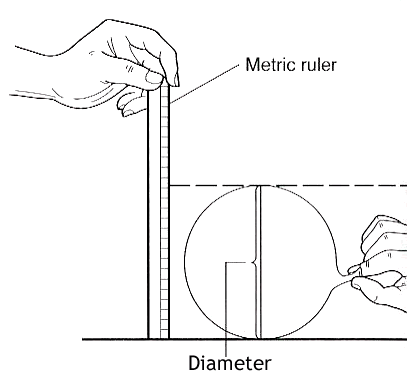 Image Credit: Shannan Muskopf / Copyrighted
Image Credit: Shannan Muskopf / Copyrighted
Figure 1. Measuring the diameter of the balloon, in centimeters (Muskopf, 2003)
-
Repeat (either step 2 or 3) so that you have three total measurements. Calculate the average diameter. Use the graph below to read the volume (in cubic centimeters) corresponding to the average diameter. Record the value in your lab notebook. (This method is from Muskopf, 2003.)
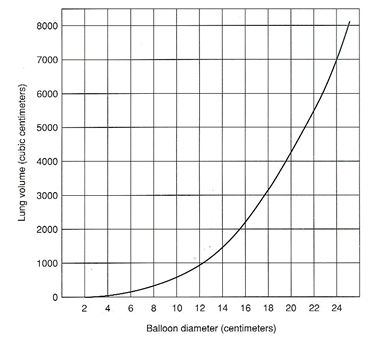 Image Credit: Shannan Muskopf / Copyrighted
Image Credit: Shannan Muskopf / Copyrighted
Figure 2. Use this graph to find the balloon volume (in cubic centimeters) for a given balloon diameter (in centimeters) (Muskopf, 2003).
Measuring Lung Capacity with the Water Displacement Method
- First you will need to mark off volumes on your jug. Begin by pouring 250 ml of water into the empty jug. Mark the water line on the bottle with a permanent marking pen. Add 250 ml more, and mark the new water level. Continue until container is filled with water. When you are finished, dump out the water, and label the lines-writing the numbers up-side-down will make them easier to read later!
- Fill the dish pan about one-quarter full of water. Keep in mind that it must have enough room left to accommodate the added water from your jug (which will be displaced during the lung capacity measurements).
- Hold your hand tightly over the mouth of the jug and turn the jug upside down in the dish pan. Remove your hand when the mouth of the bottle is below the water level line.
-
Place one end of the plastic tubing into the mouth of the jug (about 10 cm or 4 in). Keep the tubing pinched or air may leak into the jug and water leak out. A helper will need to hold the bottle so that it doesn't fall over (see Figure 3, below).
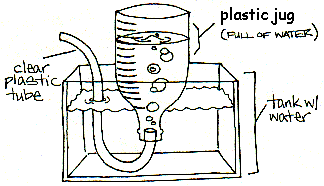 Image Credit: Chicago Academy of Sciences / Copyrighted
Image Credit: Chicago Academy of Sciences / Copyrighted
Figure 3. Diagram of the setup for measuring lung capacity using water displacement.
- Clean the free end of the tube with an alcohol wipe. (Alternatively, use a fresh disposable adapter, such as a straw or short section of plastic tubing for each participant. Make sure that there is no air leakage at the connection point.)
- To measure tidal capacity, hold your nose closed, and exhale normally into the tubing. Do not force your breathing. Record the volume of water that was displaced. This is the tidal capacity.
- Refill the bottle with water from the tub and repeat step 3 to prepare for the next measurement.
- To measure vital capacity, take a deep breath, hold your nose closed, and exhale as much of the breath as you can into the tube. Record the volume of water that was displaced. This is the vital capacity.
- Repeat each measurement three times for each participant. Allow a minute or two of rest between measurements of vital capacity. (This method is adapted from CAoS Club, date unknown.)
Calculating Expected Vital Capacity
-
The expected lung capacity can be calculated from body surface area (BSA), which, in turn, can be estimated from height (in centimeters) and weight (in kilograms) (Mosteller, 1987; Halls, 2003; Muskopf, 2003). Here is the equation for BSA:

Body surface area equals the square root of a person's height (in centimeters) multiplied by their weight (in kilograms). That number is divided by the square root of 3600 to arrive at a value for the body surface area in square meters.
Equation for estimating body surface area from height and weight: BSA (in m^2) = square root[height (in cm) × weight (in kg) / 3600]
- To estimate vital capacity (in cm3), multiply BSA by 2500 for males, and by 2000 for females.
Ask an Expert
Global Connections
The United Nations Sustainable Development Goals (UNSDGs) are a blueprint to achieve a better and more sustainable future for all.
Variations
- Do musicians who play wind instruments develop greater vital capacity than non-wind-players? How does their vital capacity compare to athletes? Design an experiment to find out.
- How quickly does lung capacity increase with regular exercise? If you have more time to complete your project, another idea would be to recruit 20 volunteers and follow them over time (at least one month). Randomly assign the subjects to two groups. Group 1 is instructed to increase their aerobic activity by at least 10% for one month. Group 2 is instructed to maintain their normal exercise regimen for one month. Ask all participants to keep a daily exercise diary so that you have a measure of actual activity. Measure each individual's tidal capacity and vital capacity at the beginning of the experiment and at one-week intervals throughout the study. Make graphs of vital capacity vs. time for each participant. Calculate the percentage change in vital capacity for each participant. What is the average change for each of the two groups? Is there a significant difference between them?
- Another idea would be to compare vital capacity between different types of athletes. Do you think swimmers or runners would have the same, greater, or lesser vital capacity than baseball players or football players? Design an experiment to find out.
Careers
If you like this project, you might enjoy exploring these related careers:



